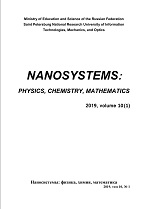|
This article is cited in 3 scientific papers (total in 3 papers)
MATHEMATICS
The behaviour of the three-dimensional Hamiltonian $-\Delta+\lambda[\delta(x+x_0)+\delta(x-x_0)]$ as the distance between the two centres vanishes
S. Albeverioab, S. Fassaribcd, F. Rinaldibc
a Institut für Angewandte Mathematik, HCM, IZKS, BiBoS, Universität Bonn, Endenicherallee 60, D-53115 Bonn, Germany
b CERFIM, PO Box 1132, CH-6601 Locarno, Switzerland
c Universita' degli Studi Guglielmo Marconi, Via Plinio 44, I-00193
Rome, Italy
d Departamento de Física Teórica, Atómica y Óptica, Universidad de Valladolid, E-47011 Valladolid, Spain
Abstract:
In this note, we continue our analysis of the behavior of self-adjoint Hamiltonians with symmetric double wells given by twin point interactions perturbing various types of “free Hamiltonians” as the distance between the two centers shrinks to zero. In particular, by making the coupling constant to be renormalized and also dependent on the separation distance between the two impurities, we prove that it is possible to rigorously define the unique self-adjoint Hamiltonian that, differently from the one studied in detail by Albeverio and collaborators, behaves smoothly as the separation distance between the impurities shrinks to zero. In fact, we rigorously prove that the Hamiltonian introduced in this note converges in the norm resolvent sense to that of the negative three-dimensional Laplacian perturbed by a single attractive point interaction situated at the origin having double strength, thus making this three-dimensional model more similar to its one-dimensional analog (not requiring the renormalization procedure) as well as to the three-dimensional model involving impurities given by potentials whose range may even be physically very short but non-zero.
Keywords:
point interactions, renormalisation, Schrödinger operators, quantum dots.
Received: 03.02.2017
Revised: 12.02.2017
Citation:
S. Albeverio, S. Fassari, F. Rinaldi, “The behaviour of the three-dimensional Hamiltonian $-\Delta+\lambda[\delta(x+x_0)+\delta(x-x_0)]$ as the distance between the two centres vanishes”, Nanosystems: Physics, Chemistry, Mathematics, 8:2 (2017), 153–159
Linking options:
https://www.mathnet.ru/eng/nano20 https://www.mathnet.ru/eng/nano/v8/i2/p153
|

| Statistics & downloads: |
| Abstract page: | 73 | | Full-text PDF : | 28 |
|




 Contact us:
Contact us: Terms of Use
Terms of Use
 Registration to the website
Registration to the website Logotypes
Logotypes







 Citation in format
Citation in format 
